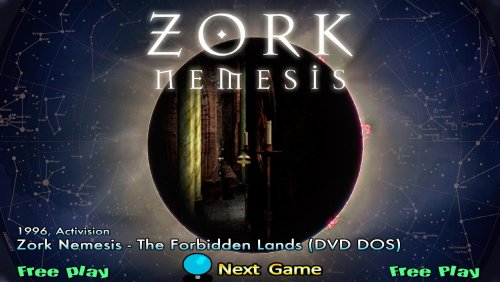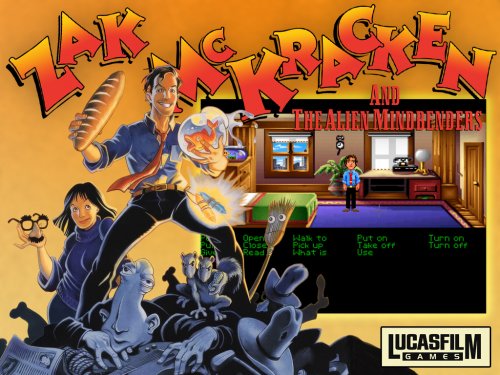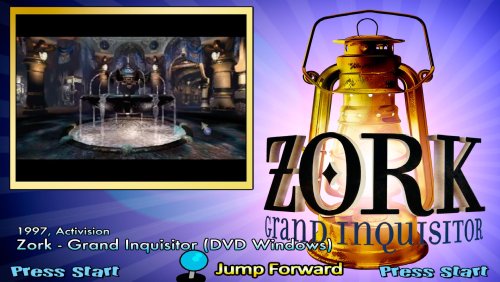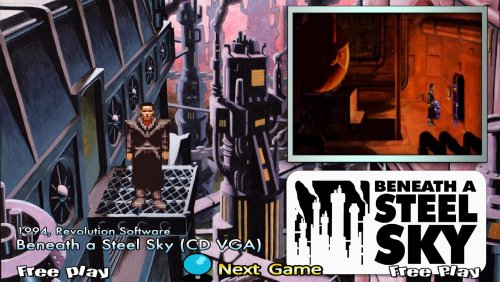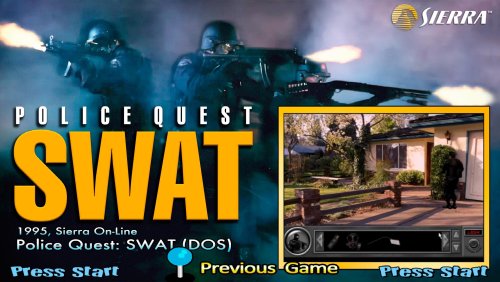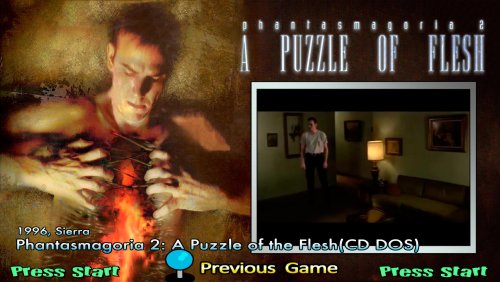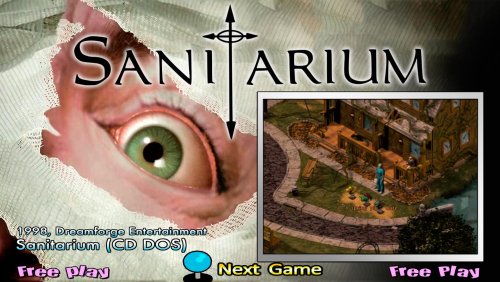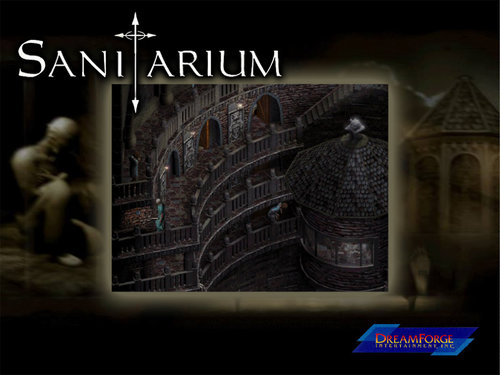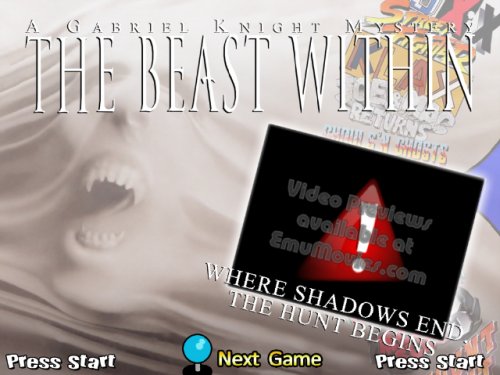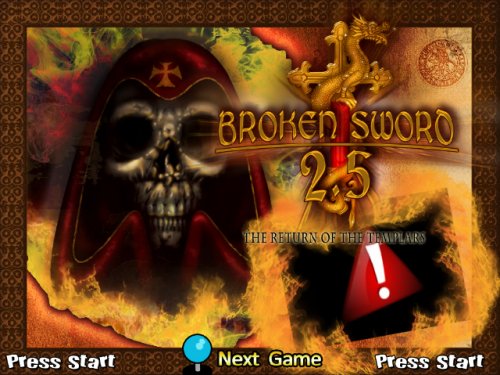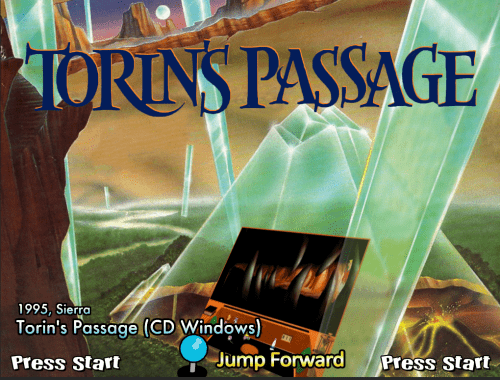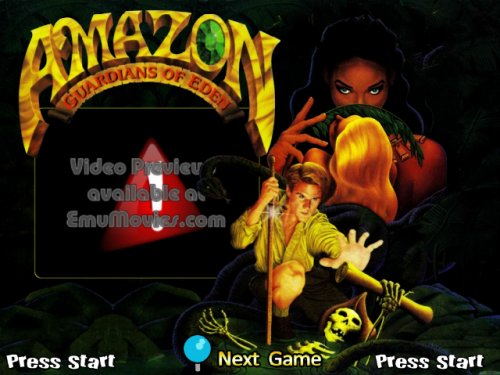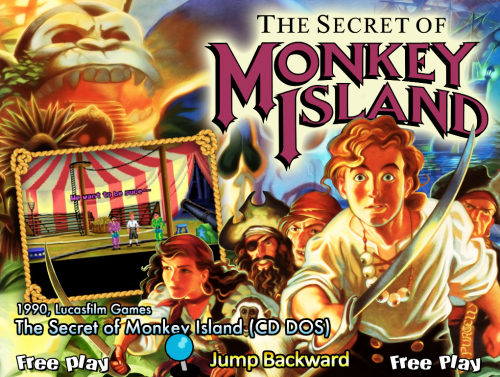Quick & dirty for this missing one.
Finally, a use case for that nebulae backdrop I did 25 years ago XD.
Enjoy!
Zork Nemesis
Keeping my scummVM system 100% themed
Wheel also available. No video included since there is a F.tons of versions.
Enjoy!
Zork Grand Inquisitor
Beneath a Steel Sky
Riven - The Sequel to Myst
Police Quest SWAT in 16x9 and 4x3 aspect ratio
Phantasmagoria 2 A Puzzle of the Flesh in 16x9 and 4x3
Gabriel Knight Sins of the Father in 16x9 and 4x3
Dirty Split in 16x9 and 4x3 aspect ratio
Sanitarium theme in 16x9 and 4x3 aspect ratio
Sanitarium is now supported by latest (2.6.0) SCUMMVM release.
Wheel & video provided as well.
Enjoy!
Rex Nebular and the Cosmic Gender Bender is a point-and-click graphic adventure game developed and published by MicroProse in November of 1992. The game is the first graphical adventure game developed by MicroProse. It was developed using the MicroProse Adventure Development system, and made use of 256-colour graphics.[1]
Tommo purchased the rights to this game and digitally publishes it through its Retroism brand in 2015.[2]
The Beast Within: A Gabriel Knight Mystery is an interactive movie point-and-click adventure game released by Sierra On-Line in 1995. Unlike its predecessor Gabriel Knight: Sins of the Fathers, released in 1993, The Beast Within was produced entirely in full motion video. The technology was popular at the time of the game's production with the recently introduced storage capabilities of CD-ROMs, but was expensive to produce. Its sequel, Gabriel Knight 3: Blood of the Sacred, Blood of the Damned used a rendered 3D engine.
In 1996, Computer Gaming World magazine named it their game of the year.[3]
Police Quest: Open Season is the fourth installment of Sierra On-Line's popular Police Quest series. Released in 1993, it was created by retired Police Chief Daryl F. Gates, who was the Chief of the Los Angeles Police Department (LAPD) from 1978 to 1992. He replaced ex-California Highway Patrol officer Jim Walls as the designer of the franchise.
The game is listed as Police Quest 4 (PQ4) in the manual. It is also shown in the file names and the credits, and when exiting the game in DOS, "Thank you for playing Police Quest IV: Open Season". The number does not appear on the title screen.
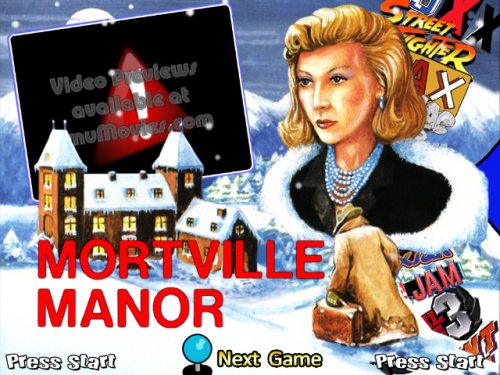
Mortville Manor (French: Le Manoir de Mortevielle) is a point-and-click adventure game developed and published by Lankhor in 1987 on Atari ST. There were several adaptations, amongst other Amstrad CPC, Amiga, IBM PC compatibles. The game was released in French, English and German. Its speech synthesis was a first at the time.
You are Jérôme Lange, a famous private investigator, involved in the strange events of the Mortville Manor. The game can be solved extremely quickly if you are given the solution. After a French computer magazine published a walkthrough, allowing its readers to solve the game without even having understood the plot, an altered version was published and replaced the original. This new version was completely identical except that at a specific point in the adventure, the player had to correctly answer a series of questions about the game's plot to be allowed to continue further.
The game was written by Bernard Grelaud and Bruno Gourier, with illustrations by Dominique Sablons with Maria-Dolores. Music and voices were provided by Beatrice Langlois and Jean-Luc Langlois. "Le Manoir de Morteveille" was subsequently translated into English (Mick Andon) and German. A version for PC was released in 1988, adapted by Clement Roques.
Mortville Manor was followed by its sequel Maupiti Island, taking place on a tropical island.
Broken Sword 2.5 The Return of the Templars is an unofficial part of the Broken Sword series. It is a game created by fans to explain what happens during the time between Broken Sword II: The Smoking Mirror and Broken Sword: The Sleeping Dragon. This fan game was originally released in German but an English voice pack was released during 2010 making the game available in both English and German. It is a short game that stays relatively true to the story and feeling of the series. As can be expected by a game created by hardcore fans of the game. The game is a freeware windows game and can be downloaded by anyone for free. The game was developed and released by german company MindFactory. The game took an entire eight years to develop and the development started in the year 2000. The final product was released on 28 September 2008. The game was an response to the gap in the story that fans see between the second and third game.
Torin's Passage is a point-and-click adventure game developed and published by Sierra On-Line in 1995. The game was designed by Al Lowe but holds the distinction of being a family friendly game by Lowe, author of the adult-oriented Leisure Suit Larry series of games.
Amazon: Guardians of Eden is a point-and-click adventure video game for MS-DOS from Access Software. It is one of the first games to feature super VGA graphics, digitized voice-overs, and an online (in game) hint system.[1] Amazon is a movie adventure game about a 1957 expedition into the heart of the Amazon basin: "a desperate, crazed message sends [the player] on a perilous search through a land where legends come to life, danger hides behind every corner, and incredible treasures wait to be discovered."

The Lost Files of Sherlock Holmes is an adventure game series developed by Mythos Software and published by the American computer game company Electronic Arts for DOS in the 1990s. The series contains The Case of the Serrated Scalpel (1992), and The Case of the Rose Tattoo (1996).
The Case of the Serrated Scalpel
The player, as Sherlock Holmes, is engaged by Scotland Yard to help with the murder investigation of a young actress. While the manner of her death suggests this is another strike by Jack the Ripper, Holmes believes someone else had committed the crime. The investigation takes Holmes and Watson to many parts of late 19th Century London, including a perfume shop, the zoological gardens, the morgue, a pub, several dwellings, Surrey Commercial Dock, Savoy Street Pier, St Pancras Station, and of course 221B Baker Street.
The graphics are VGA, with MIDI music and a few scenes with digitalized speech (in the intro and end sequence, and the cutscene at St Pancras Station. In the other scenes there are sound effects, but no speech). The player interacts with the characters through a command menu with verb icons that is intuitive for anyone who had played other adventure games of the period. In 1994 the game was released for 3DO as full talkie and the portraits of the talkers were replaced by clips with video actors.
ScummVM - ThatPurpleStuff's Themes
Greetings, I tend to post a excerpt from the corresponding Wikipedia Article, but not today.
As I am currently working on the completing the missing themes for the ScummVM system, I noticed that the themes that ThatPurpleStuff made back in 2013/2014 were not available here in the downloads section.
So without boring you any further with why and how I am hereby releasing his work as two archives, one containing the themes and the other containing the wheels.
221 themes and wheels.
Hopefully this pack will find you well and out of appreciation go over to @thatpurplestuff's Profile and write something on his wall as a thank you.

Voyeur is an interactive movie video game released in 1993 for the Philips CD-i. DOS and Macintosh computer ports were later released. A major selling point for the game was the "mature" content of the full motion video sequences, with a number of simulated sex scenes.
The player takes on the role of a private investigator hired by a member of the wealthy Hawke family in order to gain enough evidence to bring down the corrupt Reed Hawke (played by Robert Culp), CEO of Hawke Industries. Hawke has gathered his family together for the weekend to prepare for his announcement that he will be running for President of the United States. The player controls a video camera located in a building opposite to spy on the Hawke family home in an effort to gather enough evidence to destroy Reed Hawke's career. The player character's client is randomly selected each time a new game is started, and the storyline also changes according to the player's actions.
The game uses the surveillance concept pioneered by the Digital Pictures game Night Trap, but without the "trap-em-up" elements. A sequel was released for DOS and Mac OS, and a finished beta version of the sequel for Philips CD-I has been discovered and distributed on various abandonware sites.
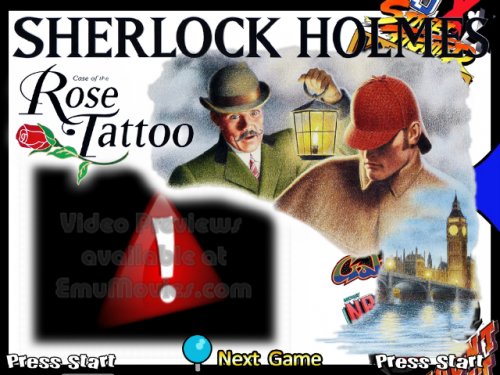
The Lost Files of Sherlock Holmes is an adventure game series developed by Mythos Software and published by the American computer game company Electronic Arts for DOS in the 1990s. The series contains The Case of the Serrated Scalpel (1992), and The Case of the Rose Tattoo (1996).
The Case of the Rose Tattoo[edit]
Holmes' brother Mycroft is caught in an explosion when his club, the Diogenes, is blown up. The player, first as Doctor Watson and then as Sherlock Holmes, investigates the explosion and discovers that it was not a gas leak but a bomb which was the cause. This leads them to investigate a case of espionage and the strange death of an unidentified man. In this game, establishing the identity of the victim is as important as finding out who killed him. The intricate plot leads the player to a great number of locations over town and involves several subplots.
The game is longer than its predecessor and features a much higher degree of historical accuracy and detail. The graphics are near-photo quality and the atmospheric sounds more are realistic, while the background music, which communicated the mood of the scenes in the first game, is applied less in the Rose Tattoo. Unlike the previous game, digitized speech is employed throughout the game and adds characterization to the NPCs.
The characters in the game were made by filming real actors in costume, against a bluescreen. While the characters are thus more lifelike, Rose Tattoo did not display large, high-quality faces shown during dialogues in the first game. A similar use of in-game video can also be found in e.g. Jones in the Fast Lane and Under a Killing Moon and in retrospect appears as a transient trend permitted by the available hardware. The CD-ROM greatly increased the data storage space available to a computer game. Most games of this period filled the empty space by enhancing the game with digitized speech and cut-scene videos. Later, advances in CPU and graphic card hardware allowed high-resolution characters to be rendered in 3D.
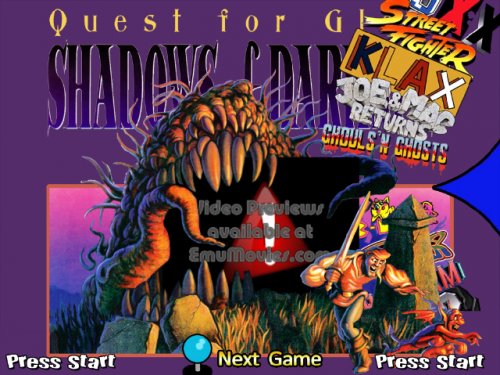
Quest for Glory is a series of hybrid adventure/role-playing video games, which were designed by Corey and Lori Ann Cole.[1][2][3][4][5] The series was created in the Sierra Creative Interpreter, a toolset developed at Sierra specifically to assist with adventure game development.[6][7] The series combines humor, puzzle elements, themes and characters borrowed from various legends, puns, and memorable characters, creating a 5-part series in the Sierra stable.
The series was originally titled Hero's Quest. However, Sierra failed to trademark the name. The Milton Bradley Company successfully trademarked an electronic version of their unrelated joint Games Workshop board game, HeroQuest, which forced Sierra to change the series' title to Quest for Glory.[8][9][10] This decision meant that all future games in the series (as well as newer releases of Hero's Quest I) used the new name.
Quest for Glory: Shadows of Darkness[edit]
Main article: Quest for Glory: Shadows of Darkness
Drawn without warning from his victory in Fricana, the Hero arrives without equipment or explanation in the middle of the hazardous Dark One Caves in the distant land of Mordavia. While struggling to survive in this land plagued with undead, the Hero must prevent a dark power from summoning eternal darkness into the world.

The game begins with Roger Wilco being court martialed for various, humorous reasons (all of which Roger, being the idiot that he is, cannot defend properly). He is demoted back to his position as second class janitor aboard the SCS DeepShip 86 (a parody of the Deep Space 9). Among the reasons for Roger being simply demoted and not expelled from StarCon is the "safe return of the SCS Eureka". This is a continuity error in that the Eureka was in fact destroyed in Space Quest V.
Later, on the DeepShip, Commander Kielbasa (named after the kielbasa sausage and a parody of the Kilrathi from the Wing Commander series of video games) announces that, as reward for their excellence in "A Glitch In Time Saves Gamma Nine" (a parody of "a stitch in time saves nine"), they are to be given shore leave on the planet Polysorbate LX ("LX" pronounced "sixty", after the preservative). Meanwhile, an extremely old and wrinkled woman named Sharpei (after the dog breed of the same name, also noted for its wrinkles, and voiced by Lucille Bliss) is revealed to be plotting Roger's demise. It is later revealed that she is the subject of "Project Immortality", which was supposed to prolong life indefinitely.
Roger's adventures throughout the game have him dealing with a T-1000 like "endodroid" (a reference mostly to the replicants from Blade Runner, including an "endodroid runner" giving Roger the assignment and speaking with a New York accent), entering cyberspace (mostly a desert canyon like area, an "office" resembling Windows 3.1, and a seemingly endless room of file cabinets known as the "file manager"), and venturing into Stellar Santiago's digestive system (for which humor is added through Gary Owens' narrations providing scientific detail of everything within each area, as if from a textbook).
Roger and Stellar develop a relationship that almost attracts Roger to the point of enamoration for her. This was designed as a way to potentially create another love interest for Roger. A running gag in the game is the inclusion of a rotting fish in Roger's inventory which he cannot seem to get rid of. It is revealed in an anti-climatic end that the fish is the only way to destroy Sharpei, who by the end of the game has become a virus infecting Stellar Santiago.
The game ends on a cliffhanger, with Stellar saying that Roger "is going to like his next mission". Despite this, Space Quest 7 never came to fruition, and the cliffhanger was never resolved.


